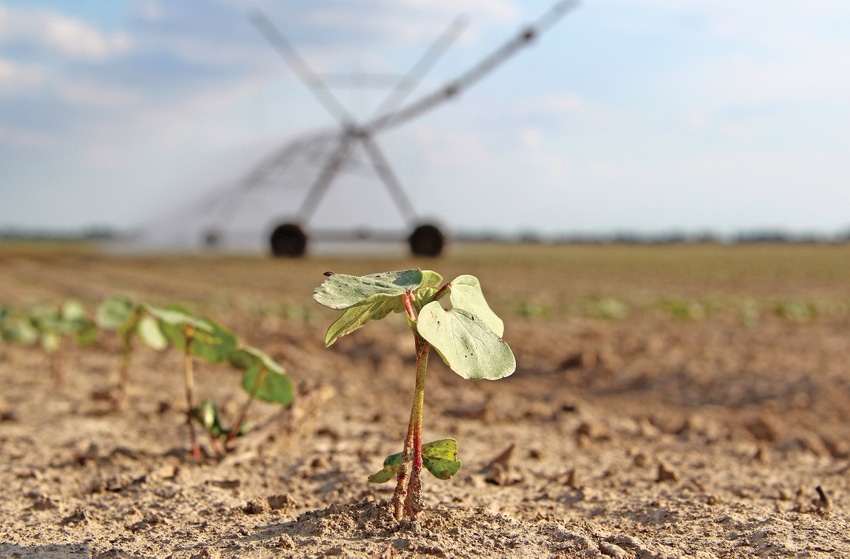
A year ago, high corn and soybean prices pushed cotton out of the mix for many Mid-South producers. Now with bearishness in the corn market and lower forecast prices for soybeans, they may be welcoming it back, although not in a big way.
Here’s more from an informal survey of farmers at the 2014 Mid-South Farm and Gin Show, in Memphis.
Thomas Watts
Thomas Watts, who farms cotton, corn, wheat and soybeans near Ridgley, Tenn., says he’s “going a little light on the corn this year, and we’ll go up a little on the cotton. We have better cotton ground than corn ground. Cotton has a pretty decent price right now. We would like to see it go up around that dollar range, but that’s going to be hard to attain.”
RELATED: Growers could plant 8.2 percent more cotton acres in 2014
Watts said his farm had “decent” yields in all crops in 2013. “We had some 3-bale cotton and we were pleased with the turnout, which was as high as 42 percent on some of it. We usually average between 33 percent and 38 percent. We were lucky because we were able to get it planted early.”
Watts’ corn yields were above average as well, even though a rising river reduced final planted acres. His biggest concern this coming season is glyphosate-resistant Palmer pigweed. “So are stink bugs and spider mites, which have been bad the last couple of years.”
Jed Anderson
Jed Anderson, who farms cotton, corn, soybeans and milo near Marianna, Ark., attributes good yields across all his crops last year to the effects of cool nighttime temperatures on plants. “We had a great cotton crop, and hopefully, these new cotton varieties are coming on strong.”
He’ll stick with his usual rotation in 2014, even with lower corn prices. “I ran budgets last week, and cotton blew everything out of the water. Cotton and soybeans are going to come to the forefront. But the milo and the corn will be there for the rotation,” to help build organic matter, bump yields and help with disease pressure and control resistant weeds.
His biggest concern about the coming year is whether prices can cover his costs of production. “All of our inputs are geared to the higher prices of the past two years, and I think it’s about to hurt us. Urea is the only thing that has come down. We booked a whole bunch when it got down to $360 a ton, and now it’s up over $460.”
Vance Taylor
Last season, Vance Taylor of Brooksville, Miss., produced cotton for the first time since 1971, planting 200 acres. He was pleased enough with the results to plan an increase to 500 acres to 600 acres this coming season. Taylor also plants corn and soybeans.
“With the yields that we’ve been getting in our area, and what we did last year, it looks like there is a whole lot more money in cotton at 78 cents to 80 cents than it is for $4 to $4.50 corn. That’s it in a nutshell.”
Taylor said the region he farms in “picked a lot of 1,000 pound to 1,200 pound per acre cotton last year, dryland.” He averaged 1,130 pounds per acre dryland, “but didn’t think the cotton looked that good at harvest. I guess it’s because I’m new to it,” he said.
“We also had good soybean yields and good corn yields. But when you put dollars against dollars for this season, it just seems like the cotton pencils out a lot better.”
Taylor hired a custom operator to pick his cotton in 2013, but the cost sent him on a quest for a used cotton picker. He found a Case with an on-board module builder. “I guess we’re committed, now.”
With the extremely wet spring in east Mississippi in 2013, Taylor didn’t get his intended corn acres planted. This season, if weather cooperates, he’ll plant between 700 acres and 800 acres and increase cotton to between 500 acres and 600 acres.
Cotton in east Mississippi should see some benefit from a new cotton gin recently completed in Noxubee County, Taylor said. “There probably would be more cotton planted in the area if there was a little bit more capacity to pick the cotton. A lot of people would plant it, but they’re afraid of the investment of the picker.”
Judd Schug
Judd Schug, Lake City, Ark., says his 2013 corn and wheat yields were outstanding, cotton was average, and soybeans, a little below average. He is 100 percent irrigated.
When asked what he’ll plant in 2014, Schug wasn’t sure. “What I’ve been telling everybody that asks is that I’m going to plant seed this spring. I’m not committed to anything right now. I’ll definitely know by the end of March what I want to do.”
Schug is focusing on commodity prices and input costs to help in that decision. Today his biggest concern is his weed control cost and glyphosate-resistant Palmer pigweed. “Pigweeds were really bad last year. They came on with a vengeance. Once that seed bank gets built up, it’s there. We had to fight them in soybeans the hardest. This year, I’ll need to use more pre-emerge and pre-plant herbicides and try to do a better job of mixing my chemistries.”
Ag news delivered daily to your inbox: Subscribe to Delta Farm Press Daily.
About the Author(s)
You May Also Like






